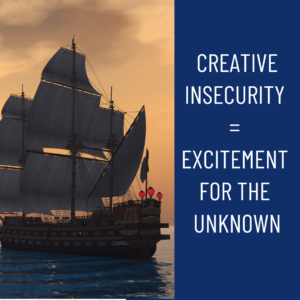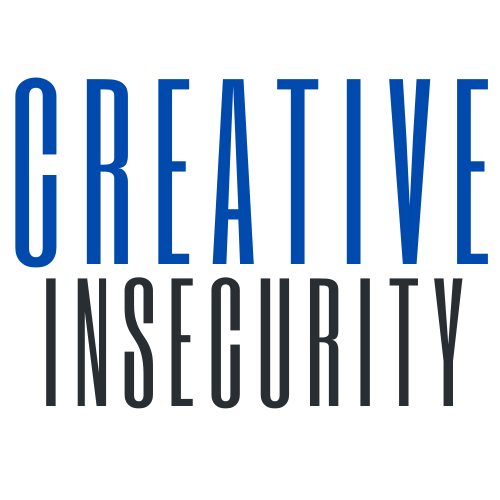What is Creative Insecurity?
What is the concept of Creative Insecurity? That is the title to my new book, and it is one that bears some explanation. In this article, I give an overview of what it means.
Insecurity relates to uncertainty
First, if the word “insecurity” makes you feel squeamish, you are not alone. The Oxford Dictionary definition carries negative connotations, including anxiety, a lack of confidence, and a feeling of being open to danger. One word of the formal definition is neutral and not necessarily negative, That word is uncertainty. Simply put, we feel insecure when a situation or outcome is uncertain. You might just as readily feel excited about an unknown outcome as you might feel anxious.
While most people think of insecurity as bad, it is neither inherently positive nor negative. Instead, this trait has opposite polarity, meaning that it has both positive and negative effects. It all depends on what you do with it. The choice is yours to lean into creative insecurity as a powerful growth catalyst or let fear-based overcorrections become a destructive force in your life.

How does insecurity make you feel?
What makes you feel insecure today, right now, as you are reading this? You might feel unsure about the future or whether your abilities will measure up to a challenge. Imposter syndrome plagues nearly everyone. You may feel like a misfit, out of place in your current environment. Perhaps you must respond to threats coming your way.
It is possible and healthy to develop creative responses to the inherent insecurity in life. You have a choice of what to do when faced with uncertainty. A positive approach is curious, open to improvisation, and ready to learn. It is an alert state of being, not a fearful one.
Creative insecurity is present in new beginnings
If you are having difficulty wrapping your head around positive insecurity, let’s begin by looking for examples in your life. Can you think of a time when you felt the thrill of a new beginning? If so, you have experienced positive insecurity. The exhilaration of new love, starting a job, or kicking off a project are all times of uncertainty that bear the markers of hopeful excitement. If you enjoy exploring and delay turning back because you’ve got to see what is around the next curve, you know the feeling of positive insecurity.
That feeling has been present in me with every new venture I have started. I get the biggest kick out of the early steps. Opening a new box of business cards or seeing a fresh logo on a website makes me feel like anything is possible. No matter my age, I always sense that my biggest deal is still ahead.
You may not be the thrill-seeking adventurer type, but perhaps your personality gravitates toward exploring in different ways. Are you blessed with an insatiable curiosity that causes you to pull on a thread until you untangle its mysteries? You might be driven to solve a problem in your work or to answer a call driven by the question, “What about this subject is so interesting?” Curiosity is a potent form of creative insecurity. The discovery process is invaluable because it reveals more knowledge. While setting out for the unknown might be scary, curiosity can motivate us to push through our fears.
Creative insecurity is the opposite of toxic insecurity
Now, let’s address the other dark side: how fear of insecurity can manifest as hubris, an inflated ego, or narcissistic tendencies. Hubris is an insidious form of toxic insecurity. You might think arrogance stems from too much confidence, but the opposite is true. As counterintuitive as it may seem, hubris stems from too little confidence, or a fear of insecurity. Hubris is an overcorrection for feelings of self-doubt or unworthiness. It feeds on fear of being small or irrelevant. In short, toxic insecurity is an attempt to compensate for feelings of what is missing, not an over-abundance of self-worth.

Creative Insecurity is a positive mindset
In business (and life) it is critical to manage our mindset. When I was a teenager I started reading self-help books and others to help me have a positive mindset. I have been a lifelong believer in aphorisms. It is so much easier to overcome insecurity when you make positive thinking a habit. I owe so much to the many authors who have influenced me, and I hope my book can pay it forward, even a small amount.
Related article: 5 books for a positive mindset
Creative Insecurity asks, “tell me more”
A person who embraces creative, humble insecurity will say, “Tell me more,” when confronted with new or uncomfortable information. They will pan the landscape seeking new information. They will use feelings of imposter syndrome to spur them into greater preparation.
Insecurity can put you in a state of readiness
Author Liz Wiseman addresses the idea that insecurity is more positive than most people realize in her book Rookie Smarts: Why Learning Beats Knowing in the New Game of Work. She explains that mastery does not bring about happiness. Instead, her research shows that people feel alive when they solve problems and grow. Contentment wanes after achieving a goal.
In this article, Wiseman states, “As our challenge level goes up, our personal satisfaction also goes up.” The real danger comes when you reach the top and stay there. “When we linger too long on a plateau,” she says, “a little part of us starts to die.”
The takeaway? Don’t get comfortable. An easy life will leave you emotionally dissatisfied without knowing why. Wiseman quotes the great poet, Khalil Gibran, “The lust for comfort, that stealthy thing that enters the house a guest, and then becomes a host, and then a master.” That is why retirement is so dangerous. Many people become sedentary and lose the spark of being challenged. People who sink into those habits lose vitality and some even die soon after leaving their careers.
In contrast to stagnation, Wiseman describes a “fire walker” position. It is an off-balance stance, thus causing forward movement. Fire walkers are careful, but they walk very fast. “You have never heard of a fire stander,” she says. Fire walkers are insecure on those coals. The lesson: if you feel hot coals under your feet, then paralysis is your enemy. Keep moving.
Insecurity has opposite polarity
In summary, rather than labeling insecurity as wholly positive or negative, it can be both. Insecurity has opposite polarity; it can be beneficial or toxic depending on whether you fear it or learn to roll with it. Harmful insecurity can lead to unhealthy reactions that are related to the body’s fight-or-flight response. Some flee or become stuck in analysis paralysis. Others come out swinging with a reckless disregard for facts.
Alternatively, you can reframe anxiousness into excitement. You can lean into your feelings of insecurity by scanning the landscape for risk. You can use it as motivation to become better prepared. These actions will result in more confidence as you venture into the unknown.
What is Creative Insecurity? Read More »

